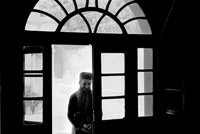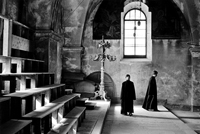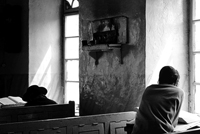
I feel that my very core photographic existence today has been a maturing or transitioning process from my earliest years as a photographer. I keep reflecting on the idea that to go forward requires continual reflection on where I’ve been.
Firstly, back to the days in graduate school, as I mentioned last week, my primary, or at least my degree focus in school, was in Theology, but… equal time in school was spent studying photography in class, and in the darkroom. I learned my craft with great discipline and rigor. I learned how to expose my film, carefully and properly, and to utilize the right developer and printing techniques, which best reflecteed my inner psychological needs. My prints were rich, very black, strong shadow detail, and contrasty.
This did not happen haphazardly. I spent hundreds of hours mixing and trying different developer and printing techniques, to nurture and achieve this emotional intensity I needed expressed in my prints. For the most part, other students achieved or wanted a tonal balance, or a full tonal range to their prints. I wanted this, but I also wanted more. I wanted the 35mm camera to achieve the technical tonal results of a large format camera. I worked and worked, never happy with the results. The image was never sharp enough, the tonality not rich or intense enough. It was a struggle to realize my potential. My hero at the time was W. Eugene Smith. My prints were like his, yet they were quite different.
It appeared to me that for most students, light was necessary to render an object or person. The purpose of light was for exposure. The more you had, the greater latitude for exposure. Of course, people have always been interested in good light, or special light, (sunrise or sunset, “the golden hours”), but no one I’m aware of ever questioned the purpose, not only of light as a source for exposure and quality, but of illumination.
Of course, if you go back a few hundred years, or perhaps even just to the 19th Century, painters were consciously, or unconsciously aware of light as a source of illumination, like the illuminated manuscripts of the Renaissance era. For me, the light I used in my photographs was not only an aesthetic choice, but rather a source of knowledge and wisdom. Light provides the illumination, which provides wisdom and knowledge. In his gospel, John, one of Christ’s disciples, refers to light as the source of all knowledge. Without it, there is only darkness and despair.
It is not that I only believe this, but in my early work, light seems to be one of the main sources of great portraiture.
The light of the Middle East, where these examples were taken, is unique. I often found myself wondering if the light reflected or created certain events. There is obviously some purpose, whether otherworldly or purely mundane, that creates the light of this geography. It is also true in Flanders, where the light is sharp and penetrating. It is no wonder that this light produced a Rembrandt and a Vermeer. And then there’s the light of Los Angeles (the city of angels), where the light is delicate and diffuse. It feels so fragile, ready to disintegrate at a moment’s notice.
For all my years as a photographer, light, as it is generally revealed through windows and doorways, is how I know someone or something. It is special to that moment, that hour, and that place, never to be repeated exactly the same again.
How I know someone is revealed partially by looking at them through the lens, but it is also by seeing them revealed, unveiled, and disrobed by the illuminating light from outside and above.



